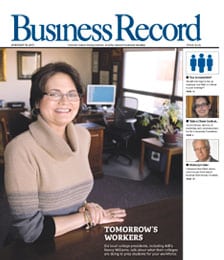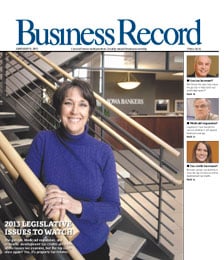Greater Des Moines’ ‘golden’ forecast

Commercial real estate market survey results forecast economic growth
Though commercial real estate brokers in major metropolitan cities around the country are experiencing “doom and gloom,” Gary Beban, senior executive managing director of CB Commercial/Richard Ellis in Chicago, says Des Moines is “golden” by comparison.
“Last year, I said Des Moines was golden, and I think it might look a little better,” he told a large crowd of investors and business leaders gathered in West Des Moines on April 22 for CB Richard Ellis/Hubbell Commercial’s sixth annual first-quarter survey. “I hope our statistics and charts prove again for the second year that you have a golden opportunity and this is a golden place.”
CB Richard Ellis/Hubbell Commercial, the largest commercial brokerage company in Iowa, contracted Frandson, Knapp and Associates, an appraisal and consulting firm, to produce its Greater Des Moines Market Survey. Brokers for the firm presented their findings in three areas of commercial real estate: office, industrial and retail.
Though Des Moines has experienced a record amount of new construction over the last 18 months, the survey found that slowing rates of absorption in industrial and retail sectors for some submarkets somewhat tarnish Des Moines’ golden status. Still, the brokers said Des Moines is doing well because it doesn’t experience the highs and lows common in major markets.
The following is a look at the findings presented at last week’s market survey meeting:
OFFICE
Growth in office space, particularly in Des Moines’ central business district, prompted Kent York, vice president of brokerage services, to say “we’re headed in the right direction.” York said even though office building construction is on the rise, Class A, B and C office occupancy rates remain stable overall.
“This stability, combined with recent office sublease space activity, is a good indicator of market momentum,” he said. “We need to focus on not overbuilding the market.”
The survey shows that the central business district saw the most significant increase in Class A ($17.50 or more per square foot) and Class B ($14-$17.49 per square foot) office inventory due to new construction. The Wells Fargo Financial building, adding 326,000 square feet of Class A space, alone resulted in a 4 percent increase for that region’s total core inventory.
The seven-story Allied/Nationwide Insurance building with 511,000 square feet and other new projects were not factored into the survey’s data.
York said the office market remains strong due to large insurance and financial service companies occupying large volumes of Class A space. He cited newly constructed offices for the Hubbell Realty Co. (26,000 square feet) and NCMIC Group (121,000 square feet), as well as the leasing of large buildings by AmerUs Group Co., National Travelers Life and Nationwide Advantage Mortgage Co., as highlights in the office market. Additionally, Stanbrough Co.s recently finished the first 30,000-square-foot multi-tenant office building in the Deer Wood Office Park development in Clive. Three additional buildings are planned for a total of 120,000 square feet.
On the downside, brokers said, occupancy of Class C space in the western suburbs plummeted as a result of a loss of more than 70,000 square feet of occupied space. Ankeny and the western suburbs experienced the most significant decrease in actual space occupied, largely due to new construction and relatively strong occupancy of Class A and B space.
Still, the total office space inventory in Greater Des Moines increased from 22,353,925 square feet in 2002 to 22,892,085 square feet in 2003, accounting for 743 total buildings in 2003, an increase of nine from a year ago. Meanwhile, total occupancy rates for Greater Des Moines slipped from a year ago, from 91.3 percent to 91.1 percent and 445,896 square feet of offices were absorbed since the previous survey.
“Those numbers are revealing because we haven’t had big spikes in the market,” York said. “We’re steady, but not strong, but I feel confident in saying this will be another good year for office leasing and building in Des Moines.”
INDUSTRIAL
Dick Powell, vice president and sales associate, said the picture of Greater Des Moines’ industrial space market is a positive one.
“Overall, occupancies for warehouse, manufacturing and flex space remain relatively strong,” he said. “While new construction remains cautious, sales and leasing of industrial space continue at a steady pace. Central Iowa has seen an increase in vacancies of warehouse and flex space, primarily on the south and west side of Des Moines.”
The survey of totals for Greater Des Moines shows that warehouse inventory, which grew from 27,387,444 square feet in 2002 to 27,568,624 in 2003, accounts for 60.7 percent of the industrial space market; manufacturing inventory, which increased from 13,065,146 square feet in 2002 to 13,120,654 square feet in 2003, accounts for 28.9 percent; and flex-space inventory, which went from 4,602,023 square feet on 2002 to 4,681,647 square feet in 2003, accounts for 10.4 percent.
Powell said flex space has become increasingly popular in the Greater Des Moines market. The majority of flex space is located in the western suburbs, like the three flex buildings completed in Urbandale totaling 80,000 square feet, and a number of flex-space and multi tenant office/warehouse projects has continued throughout the history of the survey.
Warehouse figures also are encouraging. Firestone’s proposed distribution warehouse and office near the proposed Interstate 35 interchange at Northeast 66th Avenue south of Ankeny will contain 850,000 square feet and is slated for completion in 2004. Also, in Ankeny, Sara Lee Bakery recently occupied a 45,000-square-foot warehouse and Clarke-American completed a warehouse of the same size.
Powell said approximately 1.5 million square feet of warehouse remains vacant, but when you consider the vacated SuperValu distribution center (611,000 square feet) and R.R. Donnelley printing plant (640,000 square feet) account for 1.2 million square feet of that total, the market is about 300,000 square feet over from a normal year. “That’s not too bad when you take those two buildings away,” he said.
Absorption, the net increase or decrease in actual area occupied between surveys, for warehouses in 2003 was negative with a loss of 283,607 square feet, as was manufacturing with a decrease of 331,711 square feet. But flex space absorption increased in 2003 with a total of 232,636 square feet.
“I think we’ll see moderate to good growth this year,” Powell said. “Go and spread the good news.”
RETAIL
Colleen Johnson, sales associate, said the trend in retail in Greater Des Moines is construction of conventional stores morphing into superstores, like Target and Wal-Mart. That trend, she said, “follows a continued decline of sales of conventional stores,” which fell 3 percent in the Midwest in 2002.
The survey focuses on three categories of retail: regional malls, neighborhood and community centers, and big-box retail.
Though inventory (3.1 million square feet) and total stores (387) remain unchanged from 2002 to 2003 for regional malls, occupancy is up 0.3 percent from a year ago to 92 percent for Greater Des Moines. But General Growth Properties’ $200 million Jordan Creek Town Center in West Des Moines is expected to boost those numbers significantly in 2004. General Growth officials said they might announce a new batch of tenants for the mall in late May.
“Jordan Creek is the 800-pound retail gorilla in our market,” Johnson said. “I believe it will be next year’s retail highlight.”
Johnson said retail chains like Maytag appliance stores, PetsMart, Starbucks and AT&T Wireless continue to expand, driving the neighborhood and community centers. Overall occupancy rates across Greater Des Moines remain stable at 83.3 percent, following a 4 percent decline in 2002. Occupancy of big-box stores increased across Greater Des Moines, up to 91.3 percent, as did totals for inventory and absorption. The northwest and Ankeny submarkets experienced the largest increases while the south submarket saw a significant decrease in occupancy as a result of Kmart vacating more than 87,000 square feet of space.
Steady Market
Gary Beban, senior executive managing director of CB Commercial/Richard Ellis, says the commercial real estate industry is on the verge of a “new revolution.” Compared with a decade ago, he said globalization, advances in technology and changes in work space are creating a stir in the market.
“We’re in unchartered waters,” he said. “We’re in an unbalanced market today caused by users of space.”
Those users of space, he said, include workers who are more mobile thanks to technology and thus require less office space. Some companies, he said, even encourage employees to work from home by paying them bonuses to do so.
“Our dilemma now is having a lot of construction, but negative absorption,” he said. “But while corporations will continue to experiment with the workplace, the real estate industry will continue to be an outsourced service.” Beban predicted last week in West Des Moines that the national commercial real estate market won’t be balanced until late 2005 or early 2006. But he was encouraged by how Des Moines has weathered the storm.
“The rest of us haven’t learned the discipline of Des Moines yet,” he said.







